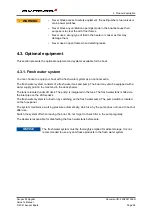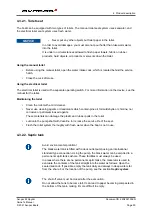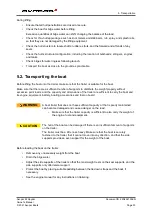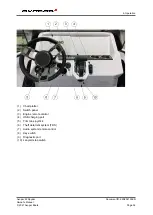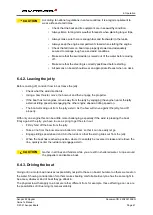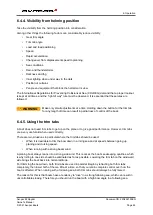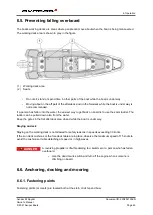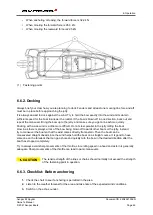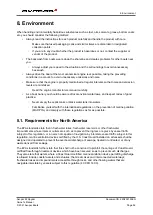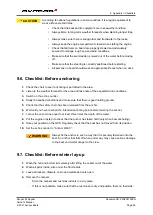
6. Operation
You can influence a boat’s behavior and the level of comfort on board primarily by adapting the speed to
the prevailing sea conditions and by the intelligent use of the trim tabs. A planing boat rides almost level
in the water at maximum speed. As the speed of the boat is reduced the trim angle increases and the
bow rises slightly. This is normal, and is a prerequisite for good performance.
6.4.3.1. Dead man's switch
If the boat is equipped with a dead man’s switch, attach its lanyard to yourself immediately after
detaching the mooring lines. For more detailed instructions, see the engine manual.
It is very important that the boat stops if you for some reason fall overboard or stumble on board,
particularly if you are alone. However, remember to detach the lanyard from your wrist before docking or
beaching operations to prevent the engine from stopping unintentionally.
6.4.3.2. Driving at high speed
Although the boats have passed the CE requirements for swerve tests at full speed, we do not
recommend making sharp turns at high speed. When exceeding a certain speed limit any hull
construction might lose its grip. This might lead to passengers hurtling out of the boat, especially in a
single engine configuration.
• Do not use the boat if it has an engine with a higher power rating than indicated on the capacity
plate.
• Do not drive the boat at high speed if the engine's rig angle is negative (bow down).
• Do not drive at full speed on congested waterways or if the visibility is limited because of
weather conditions or waves.
• Reduce your speed and wake as a matter of courtesy, and also for the safety of yourself and
others.
• Observe and obey speed limits and prohibitions associated with a swell.
• Follow the rules of navigation and the requirements of COLREG (Convention on the
International Regulations for Preventing Collisions at Sea).
• Always make sure that you have the space needed for avoiding collisions and coming to a halt
and for evasive maneuvers.
• Always use a dead man's switch if available.
• Reduce speed in high seas for increased comfort and safety.
• Learn the boat's speed potential. Utilize this knowledge for economical and safe cruising.
• Avoid using high speed along with large rudder movements when going astern, because that
places great strain on the rudder and steering mechanism.
• Avoid sudden steering maneuvers at high speeds.
• Avoid staying in the bow area when driving at high speeds.
You should avoid sudden changes in direction of travel at high speed. Let the boat come to a stop, and
the engine rev down before shifting between forward and reverse. Otherwise excessive strain is put on
the engine, which could cause the engine to stop. In the worst case, sea water may enter the engine.
A right-handed propeller rotates clockwise and a left-handed propeller anti-clockwise, seen from the
stern. The rotation of the propeller is critical for steering the boat. The right-handed propeller pushes the
stern of the boat to starboard when the engine is engaged ahead and to port when it is going astern. The
direction of rotation of the propeller has a major impact on the turning radius. A right-handed propeller
gives a smaller turning radius to port than to starboard. This is called the propeller's paddlewheel effect.
Axopar 22 Spyder
Document ID: 22S202103EN
Owner's Manual
© 2021 Axopar Boats
Page 42
-
-
Summary of Contents for 22 SPYDER
Page 1: ...OWNER S MANUAL AXOPAR 22 SPYDER ...
Page 59: ......

